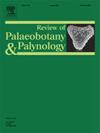In situ volcanically baked killarney fern fossils (Hymenophyllaceae) from the late Holocene of the Azores archipelago (Portugal)
IF 1.7
3区 地球科学
Q2 PALEONTOLOGY
引用次数: 0
Abstract
Among the most delicate native vascular plants present in the Azores archipelago (central Atlantic Ocean, Portugal) are the Hymenophyllaceae, known as the filmy ferns, due to their characteristic translucent one-cell thick lamina lacking stomata. Importantly, these characters impose a restriction to shaded and high humidity habitats, promoting rapid decay, leading to a low fossilization potential, as revealed by a worldwide scant macrofossil record of this family. Here we describe the first macrofossils of Hymenophyllaceae from Macaronesia, found on Faial Island, Azores archipelago. The fossils were preserved in situ within a 1000–1200 yr. BP vesicular ash-fall tuff overlain by an ignimbrite deposit. The specimens are three-dimensionally incorporated within the matrix, presenting overlapping, and are preserved as impressions with exceptional cuticular preservation. Morphological and anatomical characters match the sterile fronds of Vandenboschia speciosa, a native fern of the Azores Islands. Taphonomically, these fossils reveal that ash-fall released by sub-Plinian eruptions in oceanic islands can promote the burial and preservation of delicate plants, even when overlaid by hot pyroclastic density currents. Given the medieval age of the fossils, the associated autochthonous palaeoflora (Laurisilva), and their finding in a currently highly anthropically disturbed area, are especially important to reconstruct the palaeoecosystem baseline and inform possible future ecosystem restoration.
亚速尔群岛(葡萄牙)全新世晚期火山烘烤基拉尼蕨类化石(膜蕨科)
亚速尔群岛(中部大西洋,葡萄牙)最精致的原生维管植物是膜蕨科,被称为薄膜蕨类,因为它们的特点是半透明的单细胞厚板,没有气孔。重要的是,这些特征限制了阴凉和高湿度的栖息地,促进了快速腐烂,导致化石潜力低,这一点在世界范围内缺乏该科的宏观化石记录。本文描述了在亚速尔群岛Faial岛发现的来自Macaronesia的膜ophyllaceae的第一个大型化石。这些化石被保存在距今1000-1200年的水疱状灰渣凝灰岩中,上面覆盖着一层褐煤沉积物。标本在基质内三维合并,呈现重叠,并以特殊的表皮保存作为印痕保存。形态和解剖特征与亚速尔群岛原生蕨类植物Vandenboschia speciosa的不育叶片相匹配。从埋藏学上讲,这些化石揭示了亚普林尼火山喷发在海洋岛屿上释放的火山灰可以促进脆弱植物的埋藏和保存,即使被热的火山碎屑密度流覆盖。考虑到这些化石的中世纪时代,相关的原生古植物群(Laurisilva),以及它们在当前高度人为干扰地区的发现,对于重建古生态系统基线和为未来可能的生态系统恢复提供信息尤其重要。
本文章由计算机程序翻译,如有差异,请以英文原文为准。
求助全文
约1分钟内获得全文
求助全文
来源期刊
CiteScore
3.50
自引率
21.10%
发文量
149
审稿时长
6 months
期刊介绍:
The Review of Palaeobotany and Palynology is an international journal for articles in all fields of palaeobotany and palynology dealing with all groups, ranging from marine palynomorphs to higher land plants. Original contributions and comprehensive review papers should appeal to an international audience. Typical topics include but are not restricted to systematics, evolution, palaeobiology, palaeoecology, biostratigraphy, biochronology, palaeoclimatology, paleogeography, taphonomy, palaeoenvironmental reconstructions, vegetation history, and practical applications of palaeobotany and palynology, e.g. in coal and petroleum geology and archaeology. The journal especially encourages the publication of articles in which palaeobotany and palynology are applied for solving fundamental geological and biological problems as well as innovative and interdisciplinary approaches.

 求助内容:
求助内容: 应助结果提醒方式:
应助结果提醒方式:


